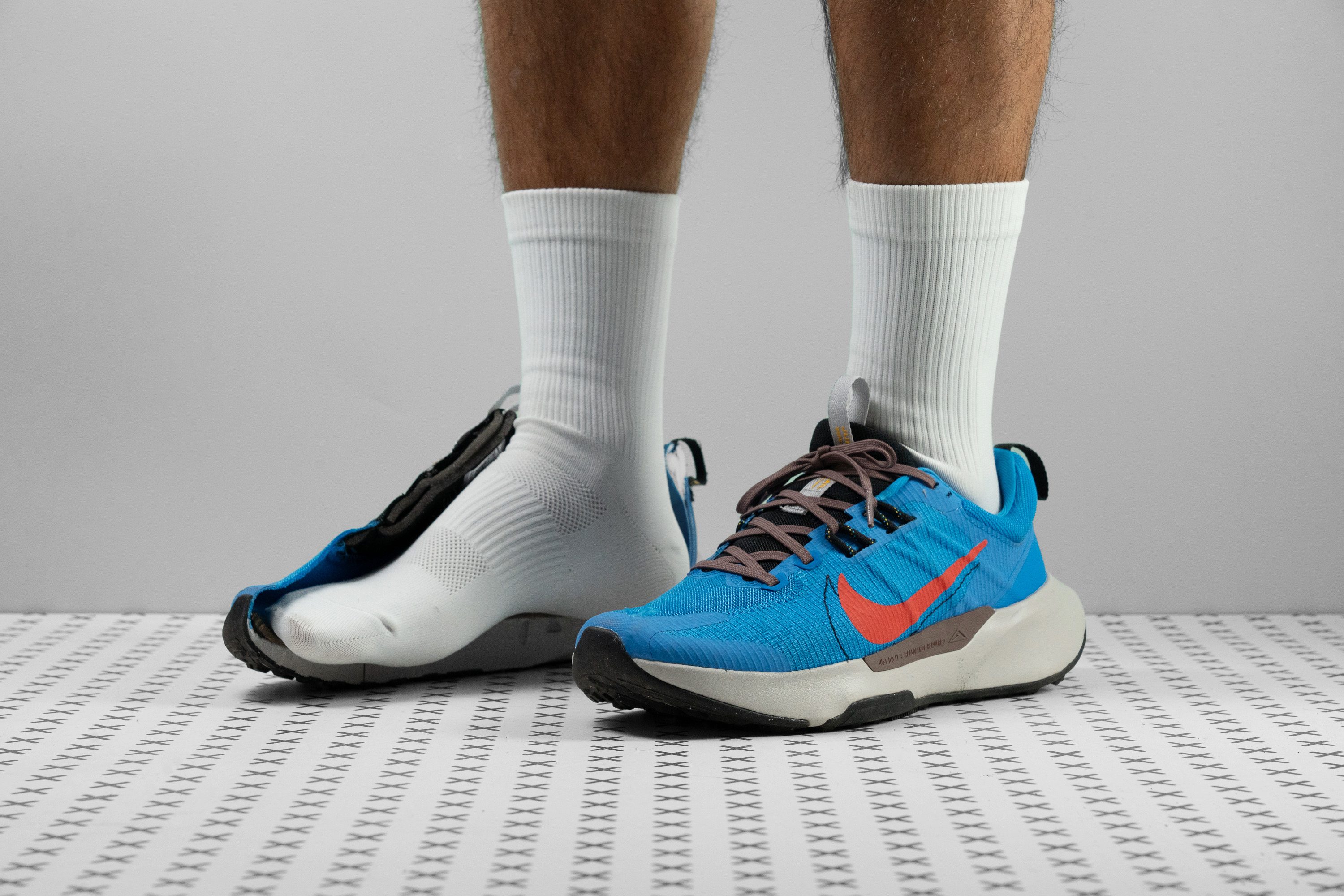Our verdict
- Top pick in best Nike trail running shoes (2023)
- Top pick in best cheap Nike running shoes (2023)
Pros
- Great value at just $85
- Durable upper
- Can handle road runs if needed
- Exceptional stability
- Perfectly suited for heel strikers
- More cushioning than v1
- Roomy and comfortable
Cons
- Grip could be better
- Might feel too firm and stiff
- Not ideal for long-distance running
Audience verdict
Comparison
The most similar running shoes compared
+ + Add a shoe | |||||
|---|---|---|---|---|---|
| Audience score | 77 Decent! | 89 Great! | 76 Decent! | 74 Bad! | |
| Price | $85 | $150 | $90 | $90 | |
| Trail terrain | Light | Light | Light | Light | |
| Shock absorption | - | High | - | - | |
| Energy return | - | Moderate | - | - | |
| Arch support | Neutral | Neutral | Neutral | Neutral | |
| Weight lab Weight brand | 10.8 oz / 306g 10.4 oz / 295g | 10.1 oz / 286g 10.1 oz / 286g | 10.7 oz / 302g 9.9 oz / 282g | 11 oz / 312g 11.5 oz / 326g | |
| Drop lab Drop brand | 9.4 mm 9.0 mm | 9.6 mm 9.5 mm | 8.0 mm 8.0 mm | 8.2 mm | |
| Strike pattern | HeelMid/forefoot | HeelMid/forefoot | HeelMid/forefoot | HeelMid/forefoot | |
| Size | True to size | True to size | Half size small | True to size | |
| Midsole softness | Balanced | Soft | Balanced | Balanced | |
| Difference in midsole softness in cold | Normal | Normal | Normal | Small | |
| Toebox durability | Decent | Very good | Good | Decent | |
| Heel padding durability | Good | Good | Decent | Bad | |
| Outsole durability | Decent | Good | Decent | Good | |
| Breathability | Moderate | Warm | Breathable | Moderate | |
| Width / fit | Medium | Medium | Medium | Narrow | |
| Toebox width | Wide | Medium | Wide | Medium | |
| Stiffness | Stiff | Moderate | Stiff | Stiff | |
| Torsional rigidity | Stiff | Moderate | Moderate | Moderate | |
| Heel counter stiffness | Stiff | Stiff | Moderate | Moderate | |
| Lug depth | 3.1 mm | 3.2 mm | 2.4 mm | 2.9 mm | |
| Heel stack lab Heel stack brand | 34.7 mm 35.0 mm | 34.6 mm 37.0 mm | 32.2 mm 32.0 mm | 33.8 mm | |
| Forefoot lab Forefoot brand | 25.3 mm 26.0 mm | 25.0 mm 27.5 mm | 24.2 mm 24.0 mm | 25.6 mm | |
| Widths available | Normal | NormalWideX-Wide | NormalWide | NormalWideX-Wide | |
| Season | All seasons | All seasons | SummerAll seasons | All seasons | |
| Removable insole | ✓ | ✓ | ✓ | ✓ | |
| Orthotic friendly | ✓ | ✓ | ✓ | ✓ | |
| Ranking | #622 Bottom 5% | #72 Top 20% | #341 Bottom 7% | #356 Bottom 3% | |
| Popularity | #264 Top 41% | #48 Top 13% | #179 Top 49% | #319 Bottom 13% |
Who should buy
We think that the Nike Juniper Trail 2 is an excellent pick for:
- Beginners looking for their first trail running experience.
- Those with wide feet seeking a versatile trail-to-road shoe.
- Road runners desiring a cheap, reliable option for occasional trail runs.
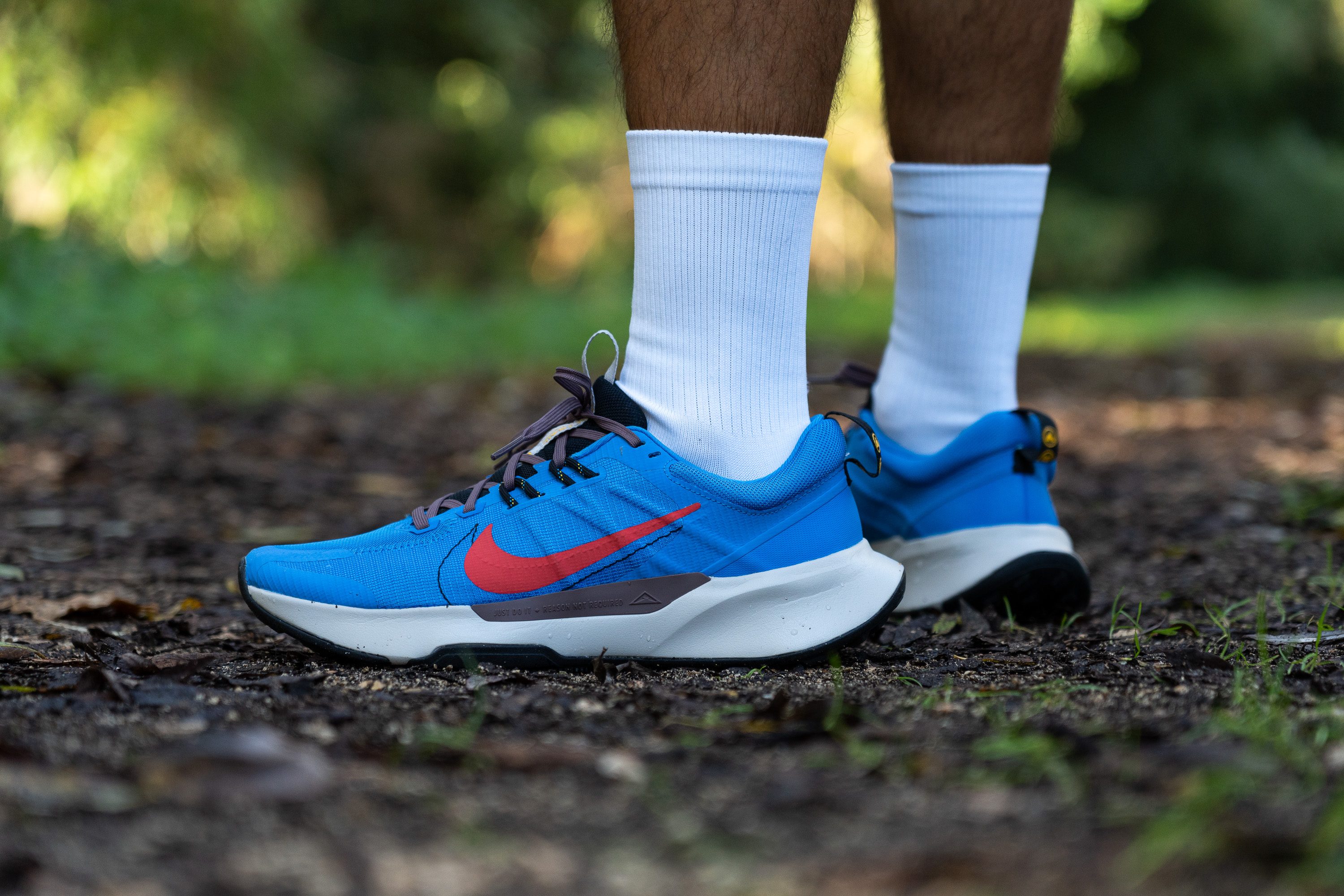
Who should NOT buy
If firm midsoles and heavier shoes aren't your thing, then the Juniper Trail 2 is not for you. In our lab, its midsole firmness and poor grip were absolute deal-breakers. In that case, a softer, lighter option like Brooks Divide 4 could be a smarter choice.
Also, keep in mind that in its quest for stability, the Juniper Trail 2 compromises a bit on comfort for walking and hiking. If that's a priority for you, we found the ASICS Gel Venture 9 to be a better pick for those activities while still ticking most of the boxes that the Nike does.
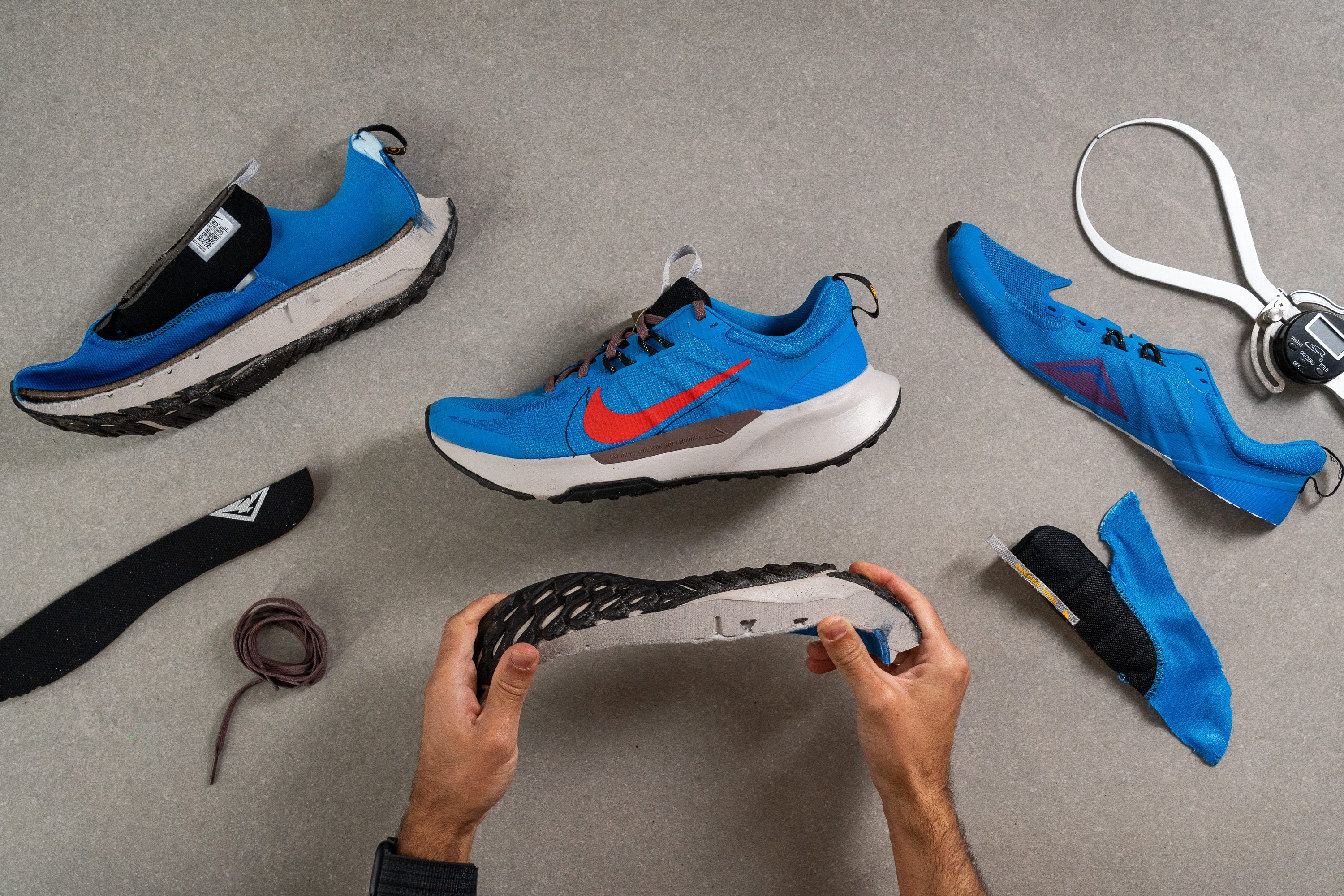
Cushioning
Heel stack
Back in the day, budget-friendly shoes typically featured low-to-mid stack heights, but that's no longer the case.
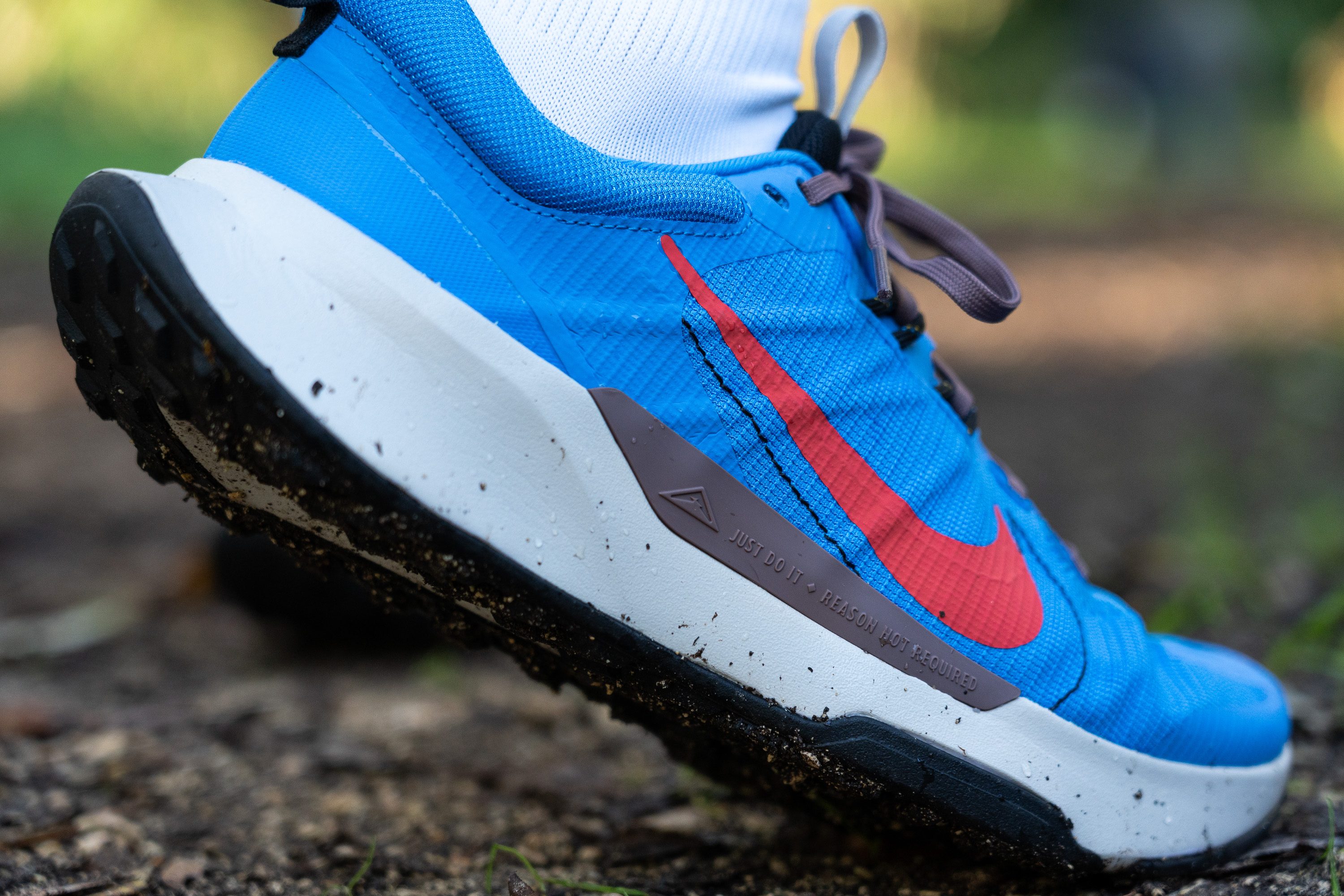
Since last year, most shoes have been easily surpassing the 30-mm mark, and the Juniper Trail 2 is a testament to this trend.
With a stack height of 34.7 mm, it even has almost the same height of the Pegasus Trail 4 and, wait for it, 8.1 mm higher than the first-generation Juniper Trail.
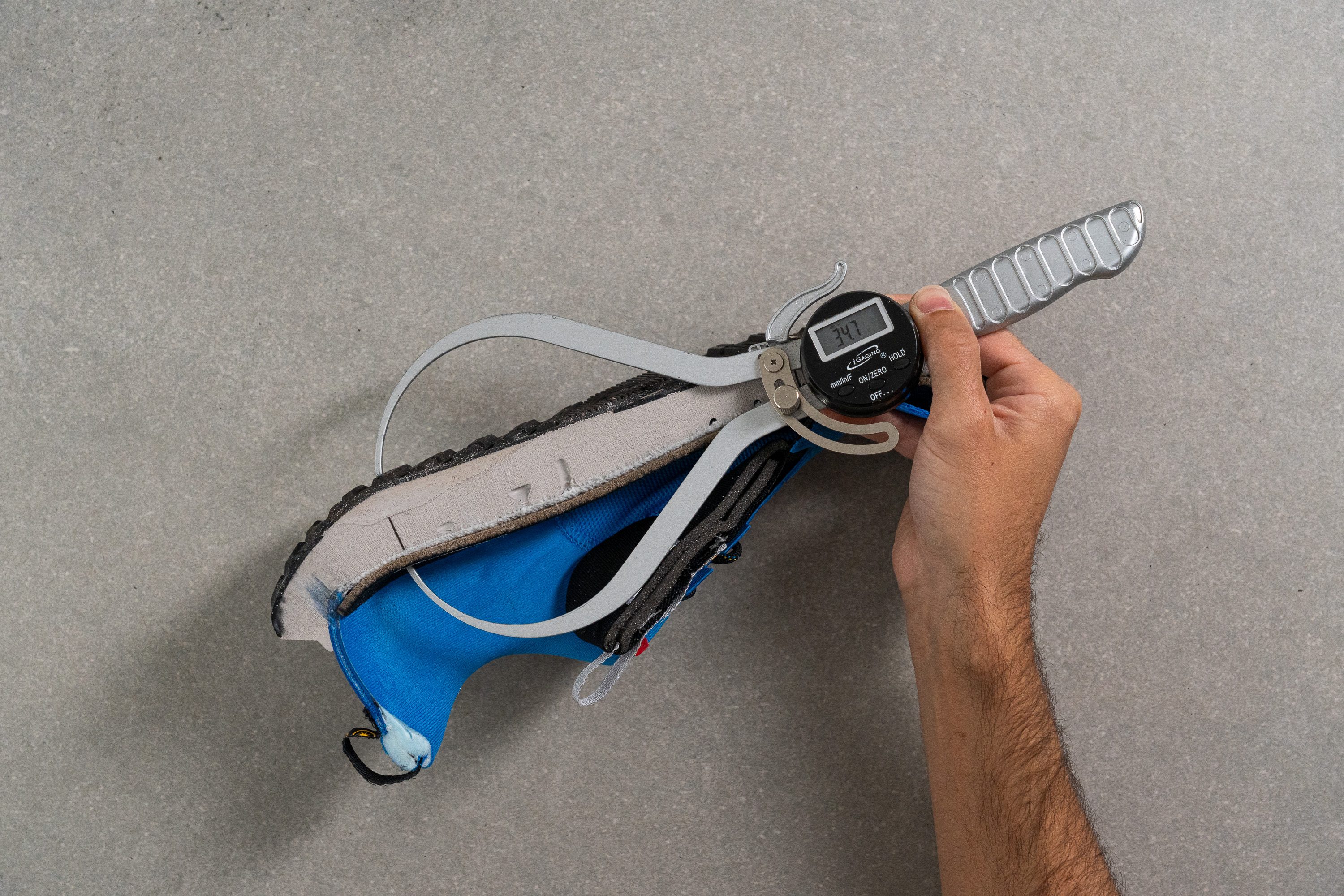
| Juniper Trail 2 | 34.7 mm |
| Average | 32.6 mm |
Forefoot stack
The forefoot measures 25.3 mm according to our precise measurements.
This also assures midfoot and forefoot strikers that the shoe provides a good amount of cushioning for muscle protection.
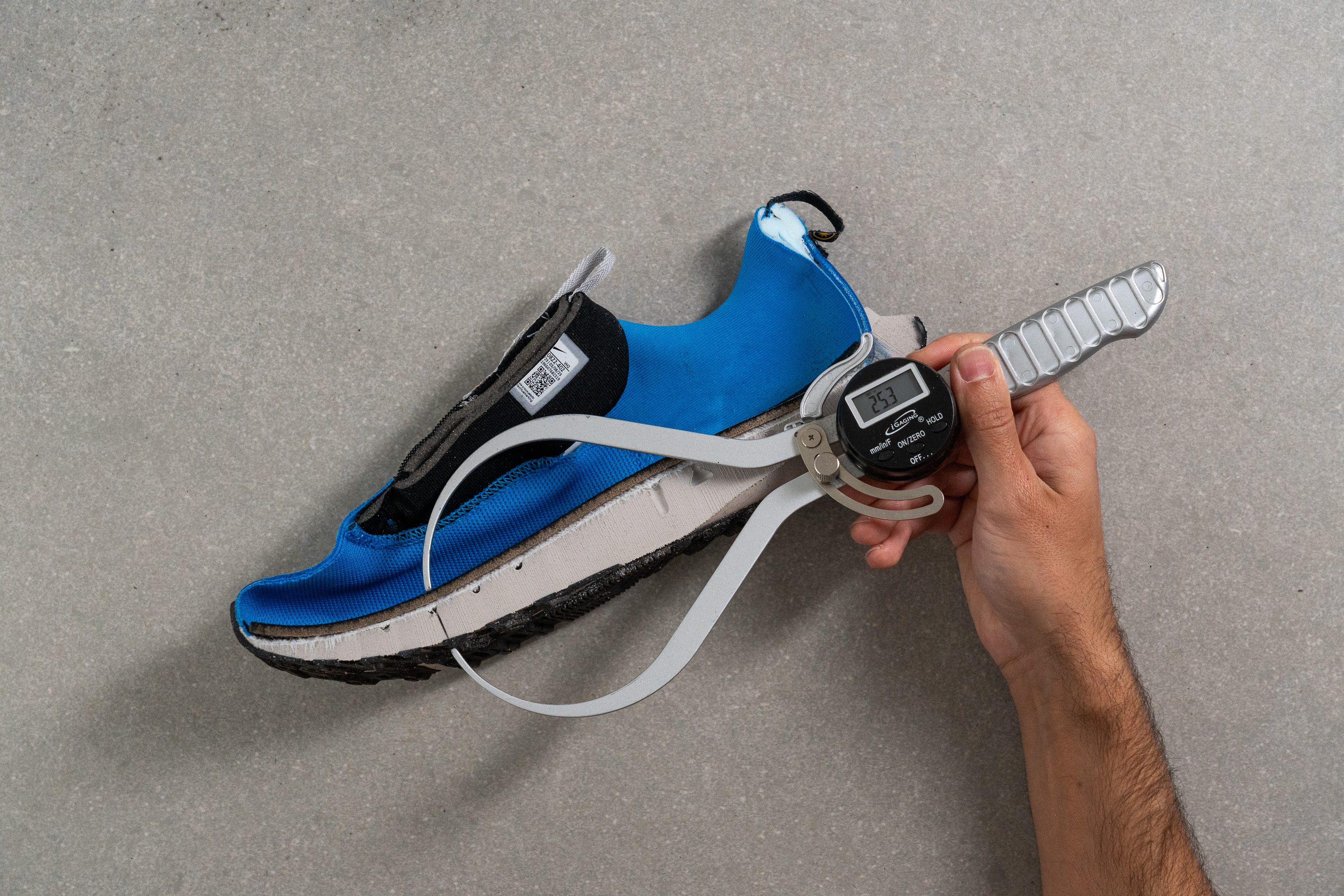
| Juniper Trail 2 | 25.3 mm |
| Average | 25.1 mm |
Drop
The difference between the heel and forefoot results in a 9.4-mm heel-to-toe drop.
We believe that anything within the 8-to-10-mm range is a solid choice for accommodating all footstrikes. This seems to us like a wise and well-thought-out decision from Nike for this type of shoe.
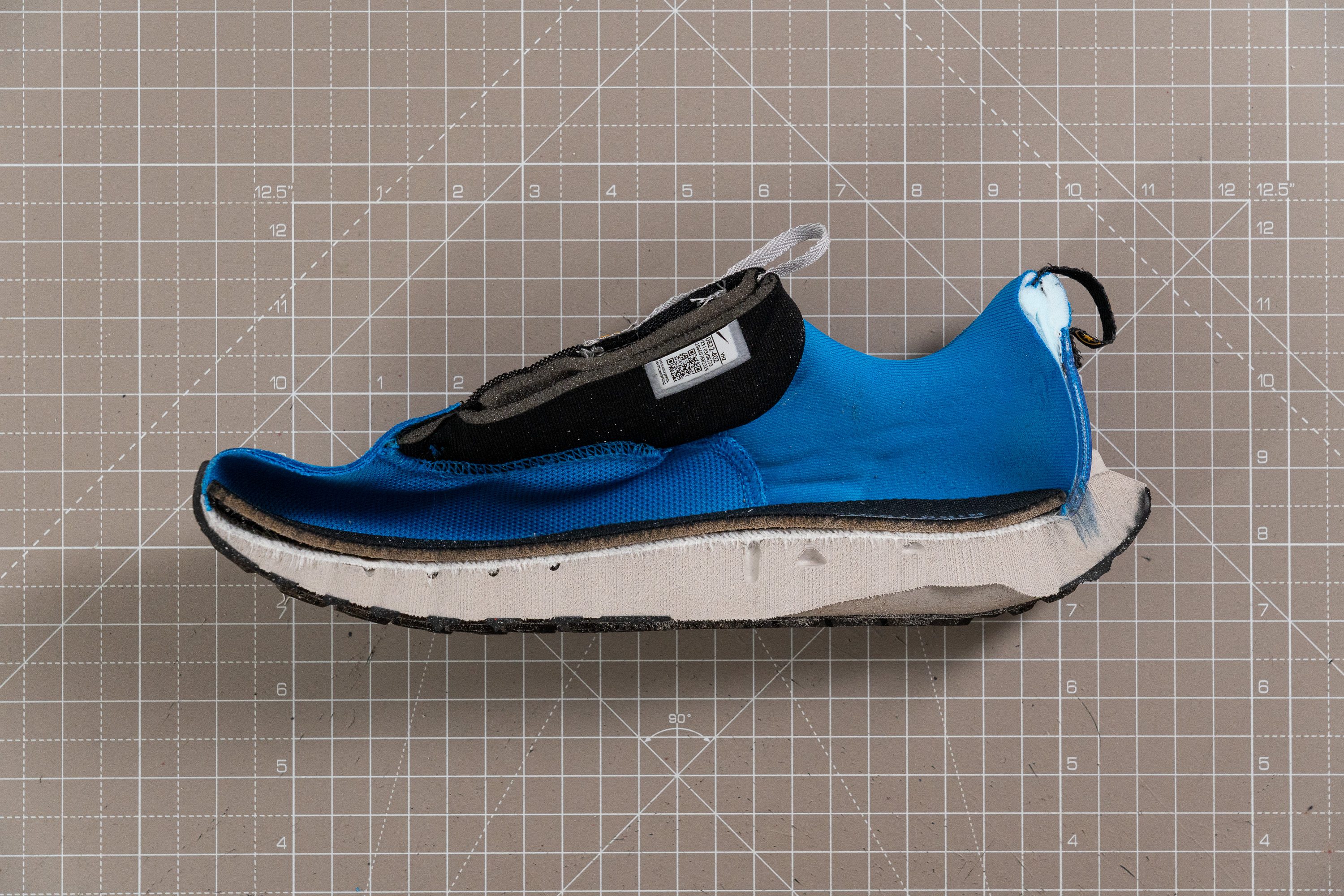
| Juniper Trail 2 | 9.4 mm |
| Average | 7.6 mm |
Midsole softness
Like most budget-friendly shoes, the Juniper Trail 2 doesn't have plush, squishy foam.
With a reading of 27.1 HA on our durometer, you can expect a moderately firm ride. However, this firmness comes with a few benefits, such as added stability.
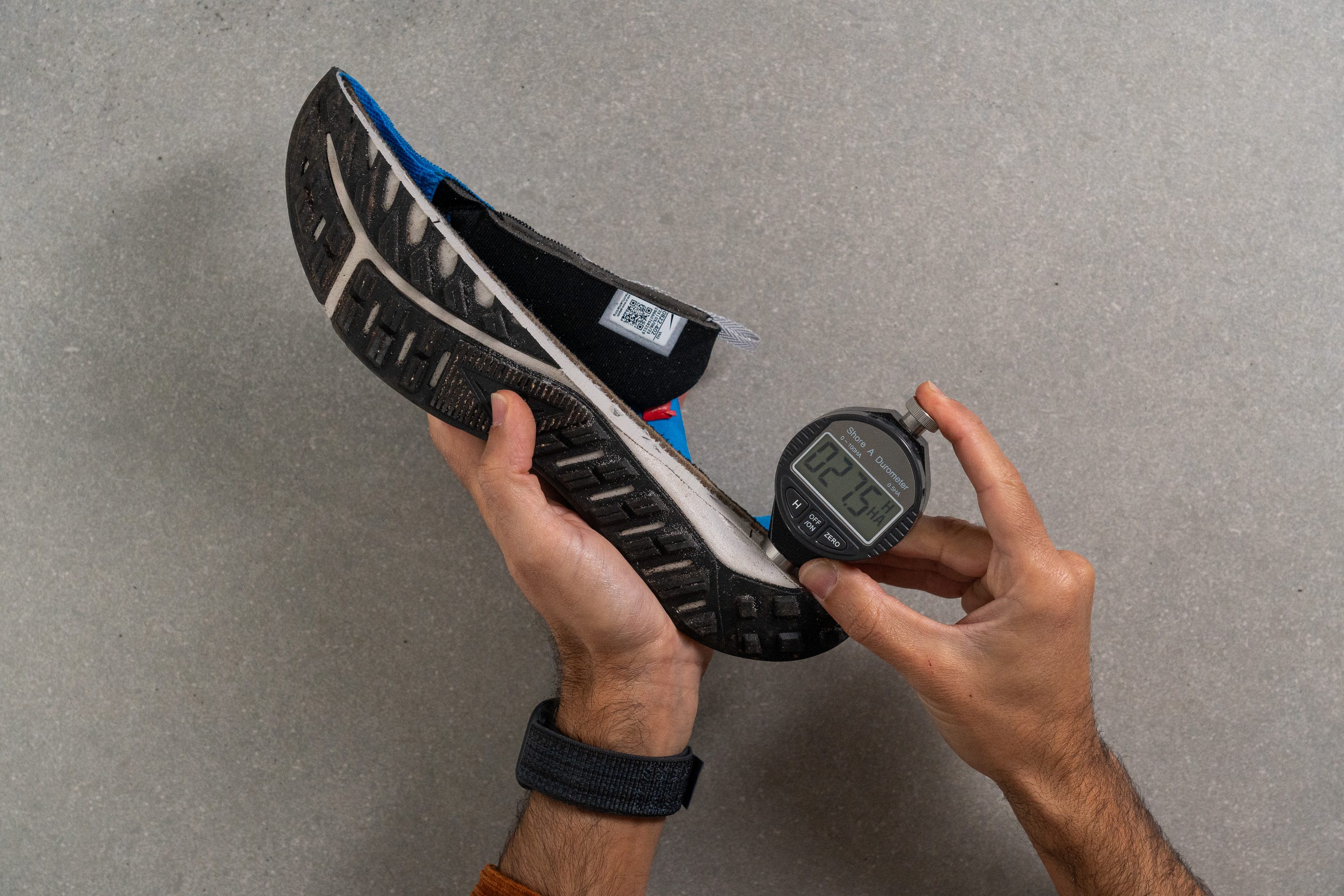
| Juniper Trail 2 | 27.1 HA |
| Average | 21.9 HA |
Size and fit
Size
Nike Juniper Trail 2 fits true to size (106 votes).
Width / Fit
The toebox is surprisingly spacious for a Nike shoe, measuring 101.3 mm. Considering Nike's recent releases, such as the racing-focused Ultrafly, and based on our thorough analysis, it seems we might soon stop associating Nike with narrow designs!
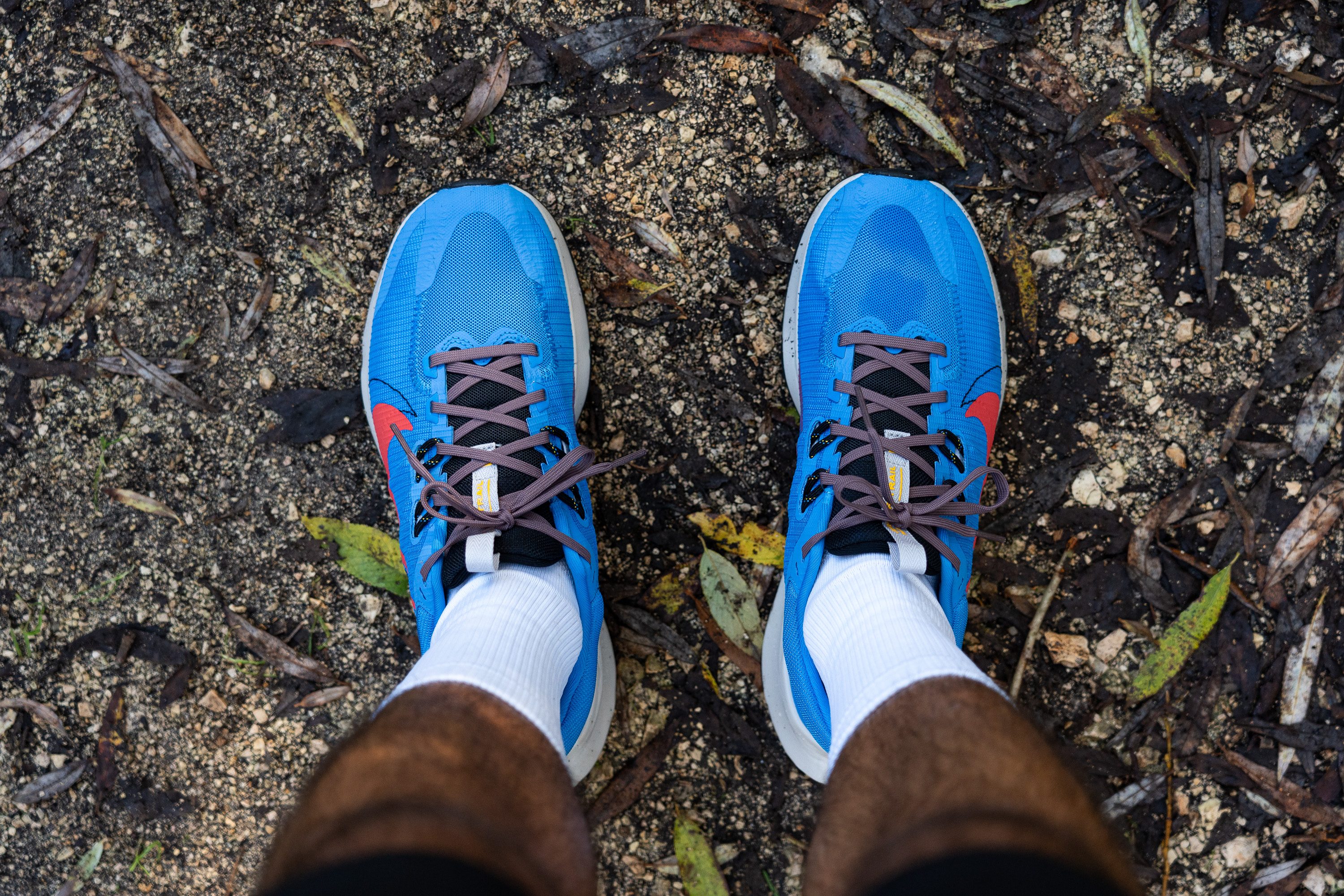
This is a welcome change, signaling that the world's most popular brand is finally accommodating those with wide feet.
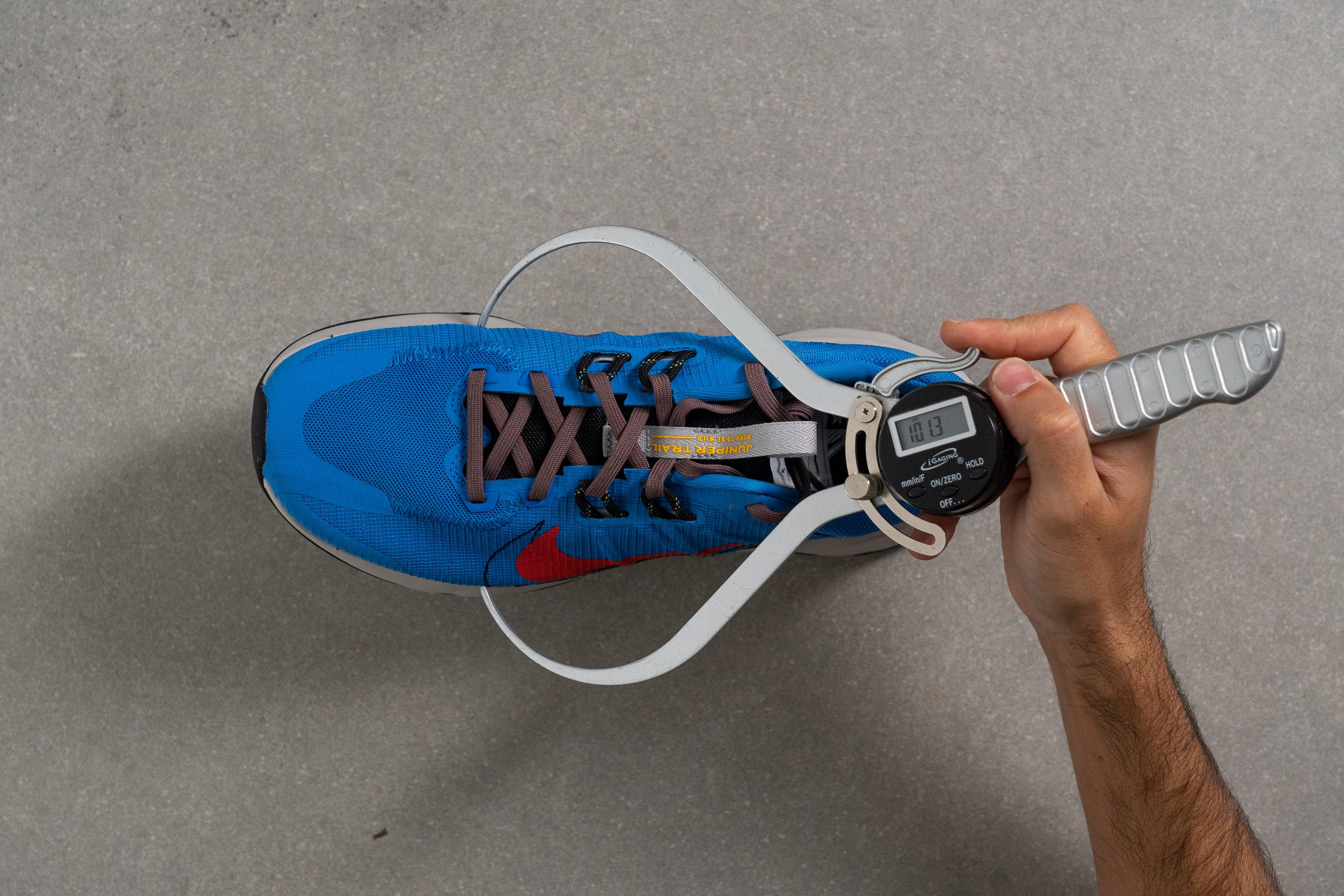
This test follows an older methodology, which is why you don't see recently tested shoes in the chart. Results from different methodologies can not be compared.
| Juniper Trail 2 | 101.3 mm |
| Average | 98.9 mm |
Toebox width
The big toe area is exceptionally roomy, measuring 82.0 mm, which is quite remarkable.
This might even be excessive for some, as those with narrow or even medium-sized feet could find it overly spacious, feeling like there's too much room in the toe cap.
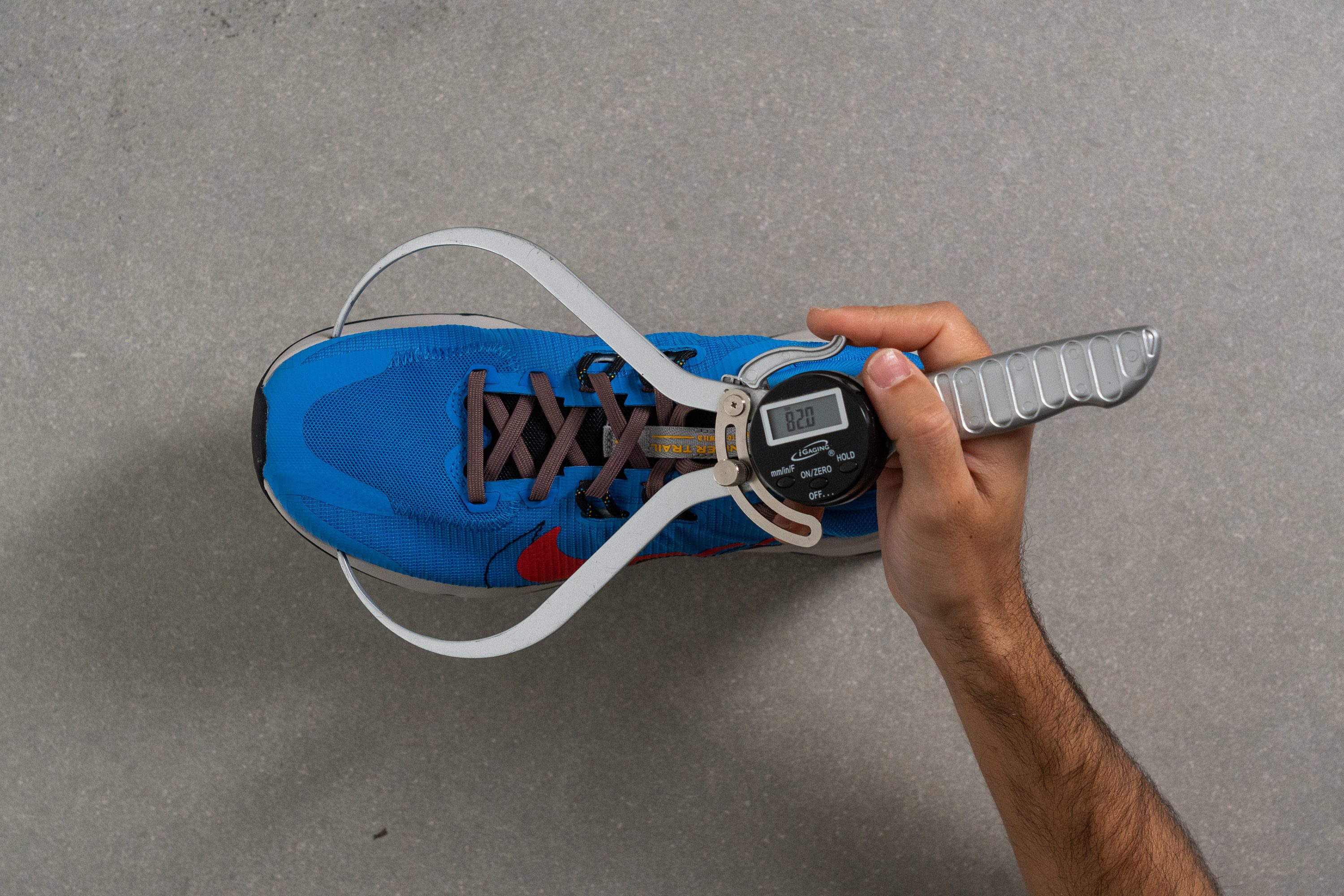
This test follows an older methodology, which is why you don't see recently tested shoes in the chart. Results from different methodologies can not be compared.
| Juniper Trail 2 | 82.0 mm |
| Average | 79.3 mm |
Traction / Grip
Lug depth
Targeted at beginners and those looking for a versatile trail-to-road shoe, Nike smartly chose to use short, 3.1-mm lugs.
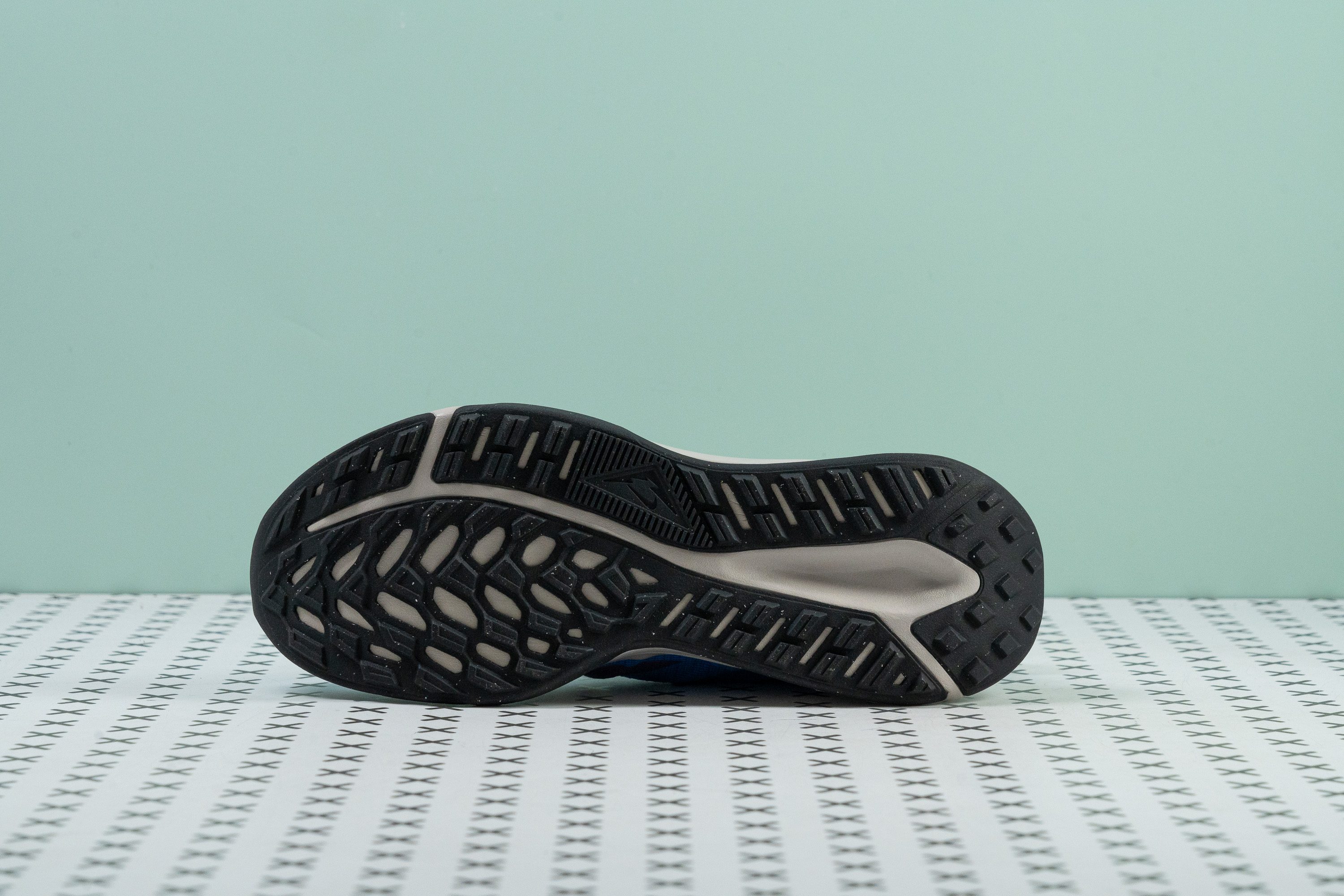
Due to this design, it may not excel on technical trails, but it will provide decent traction in most other environments.
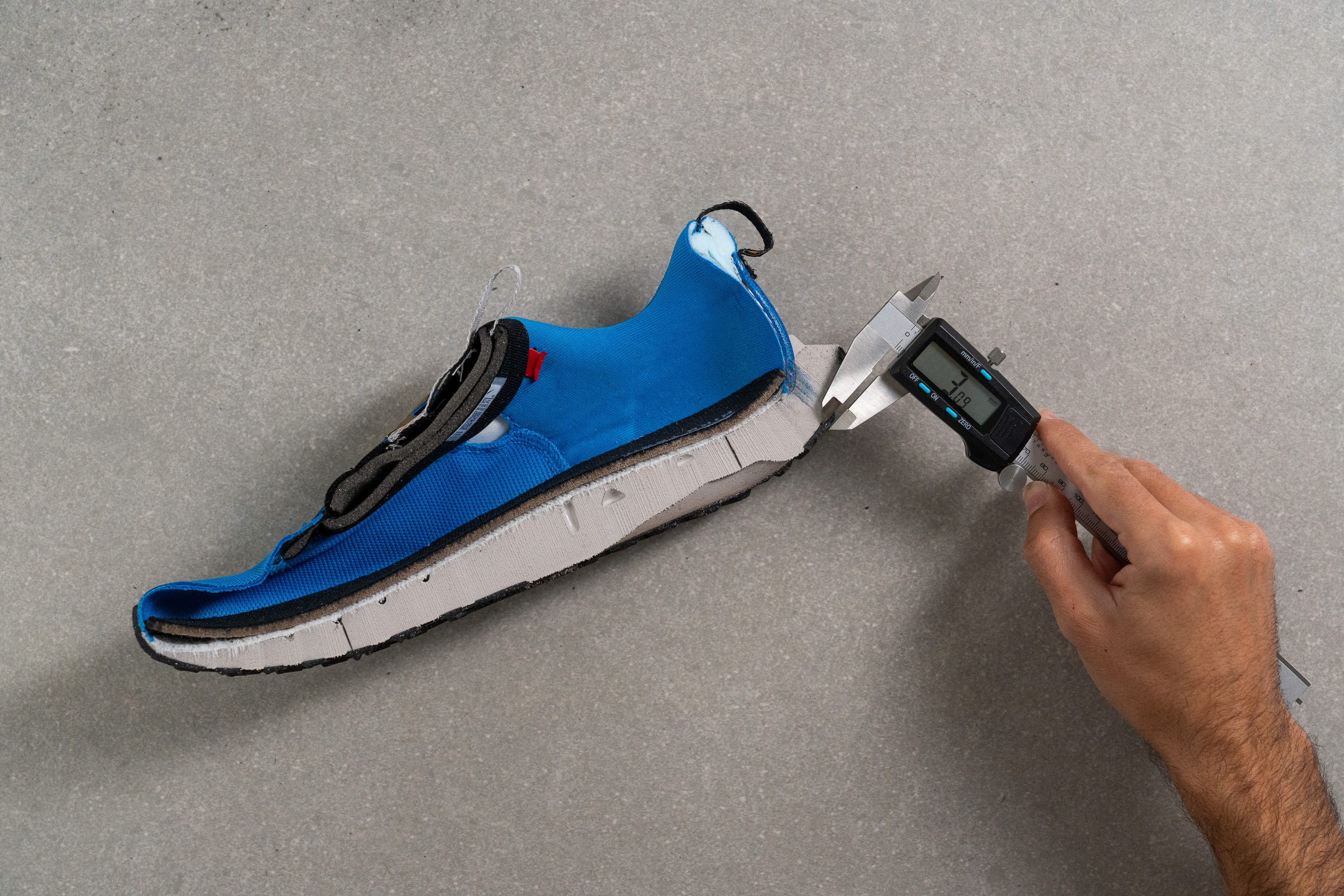
| Juniper Trail 2 | 3.1 mm |
| Average | 3.5 mm |
Flexibility / Stiffness
The Juniper Trail 2 is quite stiff torsionally, but in our 90-degree bend test assessing longitudinal stiffness, it scored low at only 22.5N. While this might seem at odds with the torsional test results, it's a typical outcome for shoes without a carbon plate.
This test follows an older methodology, which is why you don't see recently tested shoes in the chart. Results from different methodologies can not be compared.
| Juniper Trail 2 | 22.5N |
| Average | 27.1N |
Stiffness in cold
Similar to our midsole softness test, we repeated the procedure after a 20-minute stint in the freezer. This time, the Juniper Trail 2 required us to apply 36.8N of force.
| Juniper Trail 2 | 36.8N |
| Average | 35.9N |
Stiffness in cold (%)
This represents a 63.1% difference, which, while not ideal, is in line with what we expect from an entry-level, EVA-based foam. So, there are no real complaints from our side, but this one will feel like a mud block underfoot in the coldest days of the year.
| Juniper Trail 2 | 63% |
| Average | 32% |
Weight
At 10.8 oz (306g), the Juniper Trail 2 is slightly heavier than the average.
However, it feels comfortable while running at easy or moderate paces. But if you're looking for something lighter, check the Saucony Peregrine 13.

| Juniper Trail 2 | 10.8 oz (306g) |
| Average | 10.2 oz (289g) |
Breathability
Trail running shoes often struggle to achieve optimal breathability because brands need to add thicker, more durable layers that restrict airflow. However, the Juniper Trail 2 manages a respectable 3 out of 5 in our breathability test.
After setting aside our smoke-pumping machine, we examined the cut-in-half shoe under a light. We noticed that the toebox is the thinnest part of the upper, which is where most of the airflow occurs in this shoe.
Under the microscope, we observed a thick engineered mesh without any large ventilation holes, which was expected.
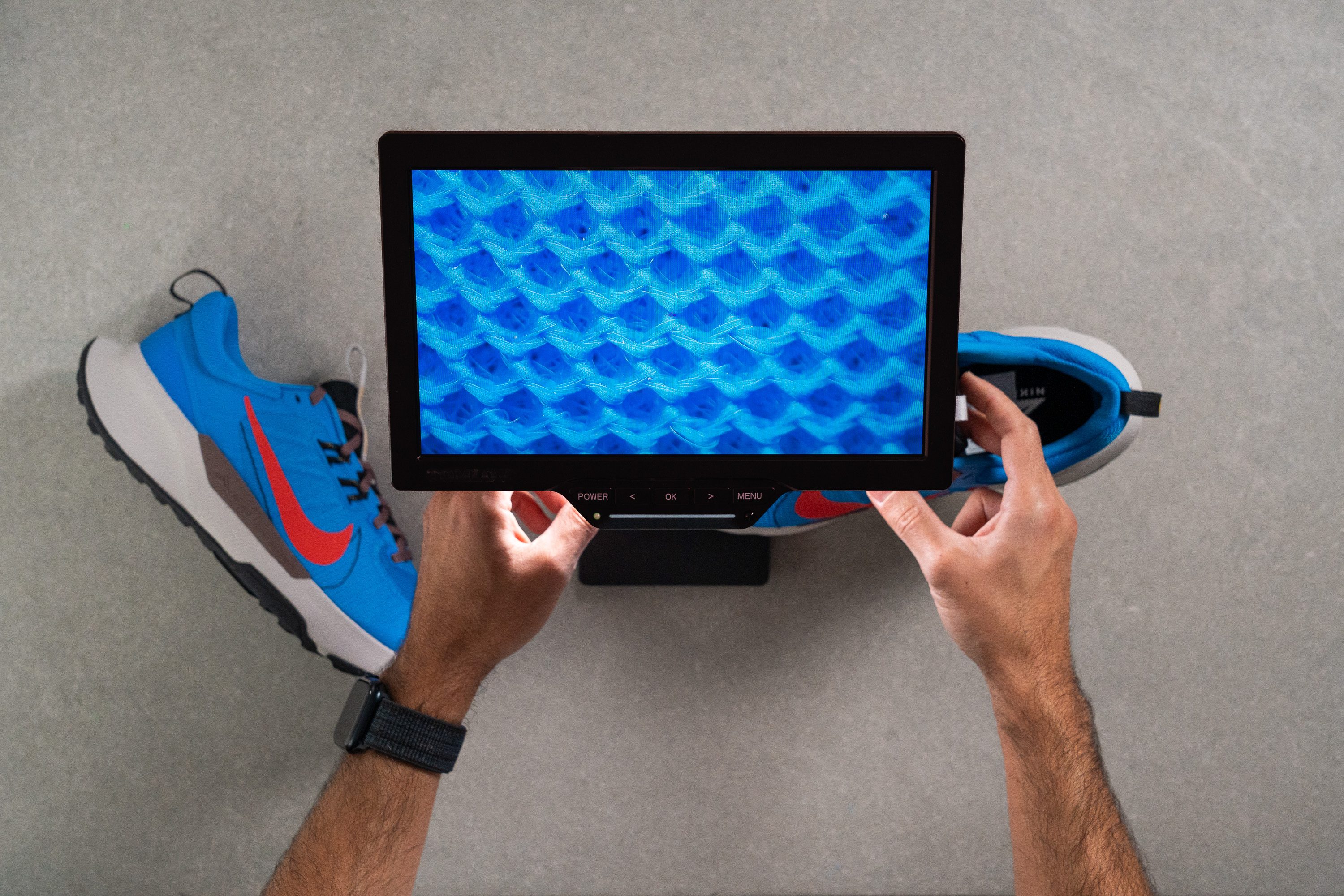
We always enjoy closely analyzing shoe uppers; they reveal fascinating patterns.
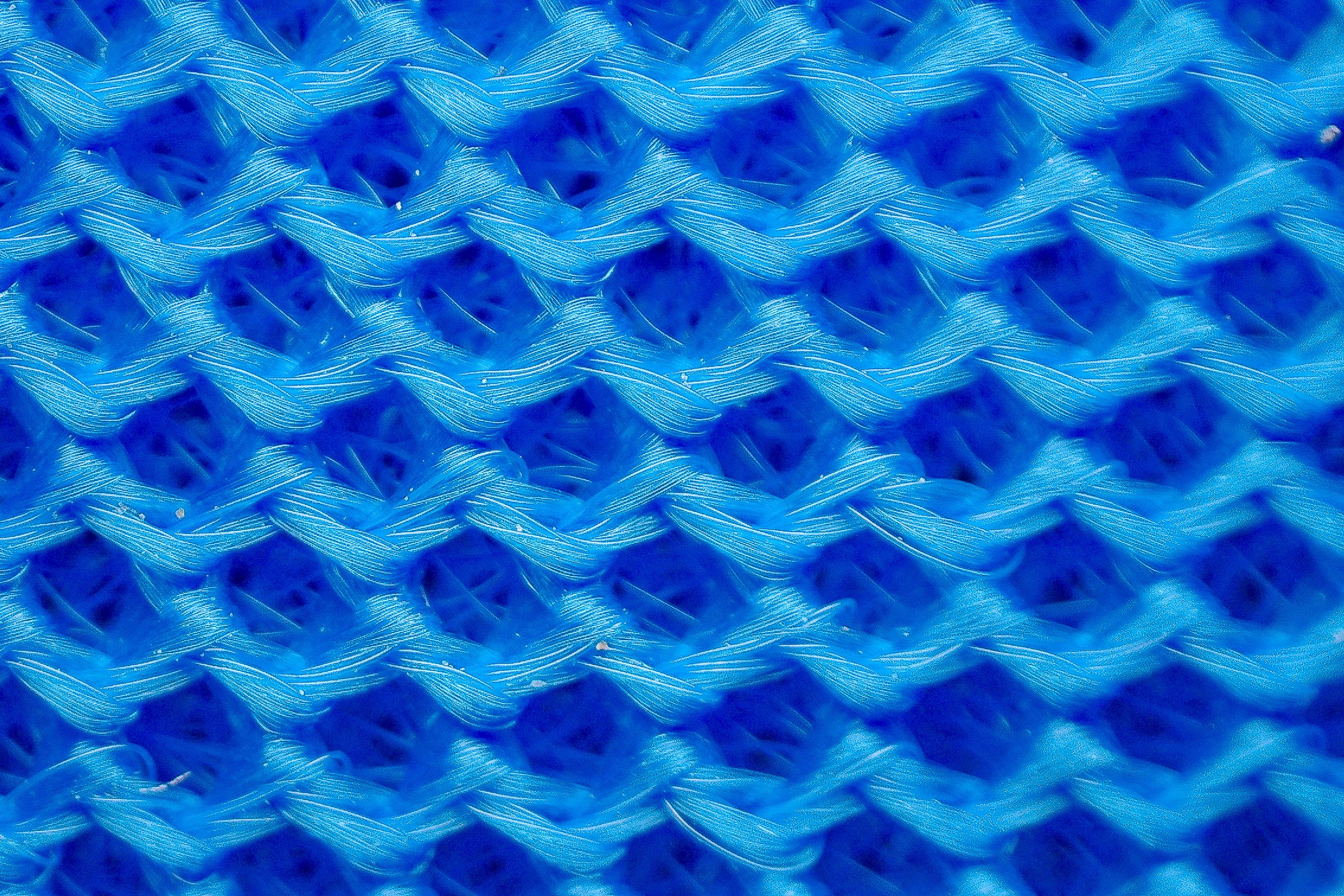
During our final inspection of the upper for breathability, we also found an inner fabric designed to enhance comfort and protect the feet from stitching, which impacts airflow.
Considering these factors, a 3/5 is a commendable result.
| Juniper Trail 2 | 3 |
| Average | 3.2 |
Stability
Lateral stability test
As mentioned earlier, the advantage of a moderately firm midsole is enhanced stability.
Considering its tall stature, we were also really pleased with the stable feel it provided during our runs.
Torsional rigidity
Another crucial aspect of the Juniper Trail 2's stability is its mind-boggling torsional rigidity. In fact, we awarded it a score of 5 out of 5.
This stiffness is clearly a deliberate design choice, especially since the shoe doesn't have a carbon plate. Naturally, the trade-off here is a bit of comfort, but this makes the shoe even more attractive to those concerned with stability.
| Juniper Trail 2 | 5 |
| Average | 3.6 |
Heel counter stiffness
The heel counter is stiffer than average, adding to the shoe's less comfortable, stability-focused design. If you have sensitive Achilles tendons, you might want to think twice about this model.
| Juniper Trail 2 | 4 |
| Average | 3 |
Midsole width - forefoot
Our measurement of the midsole width in the forefoot came in at 113.7 mm, which is good enough to maintain a stable ride. We believe Nike might have considered going even wider, but that would have added too much weight to an already heavy shoe.
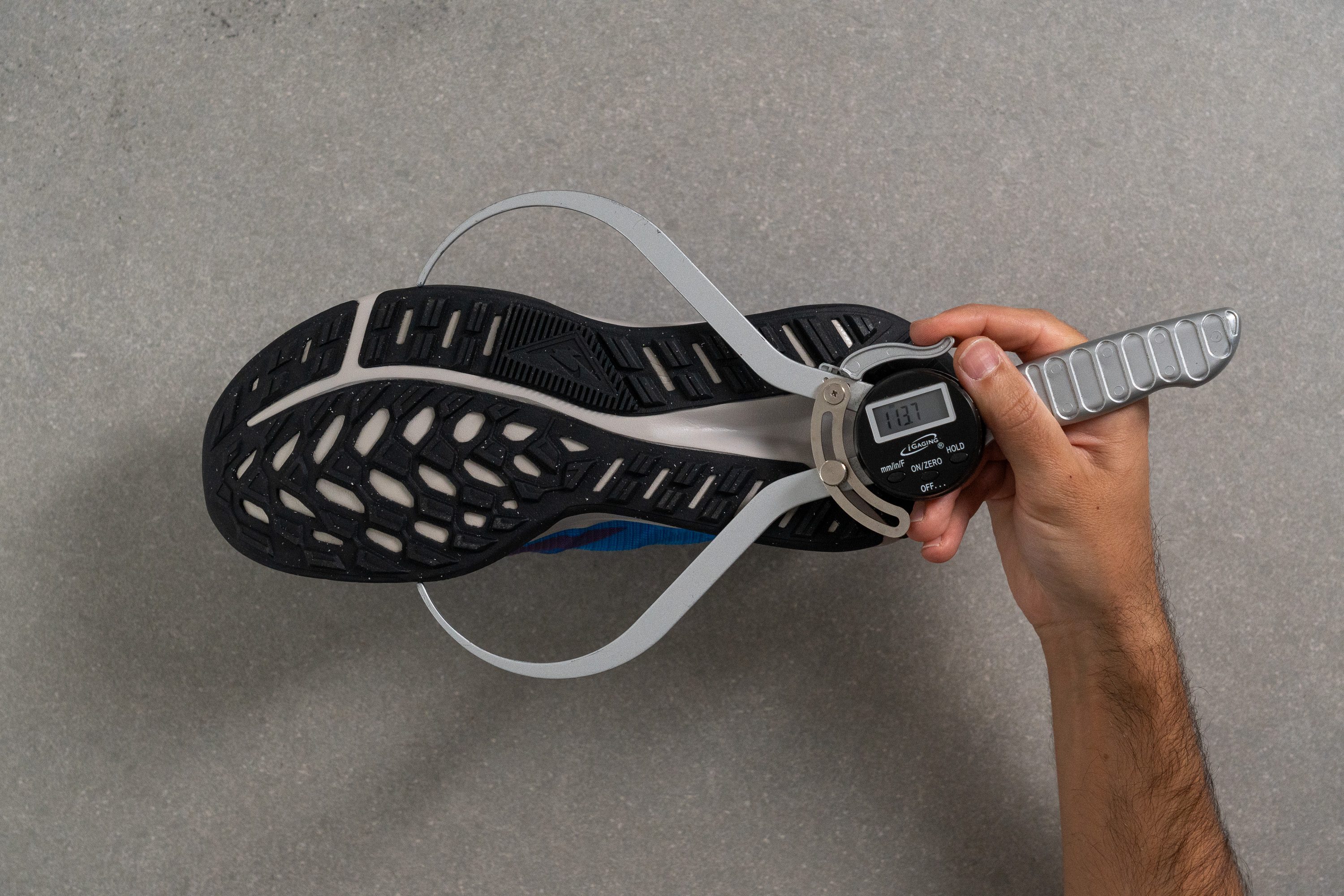
| Juniper Trail 2 | 113.7 mm |
| Average | 112.8 mm |
Midsole width - heel
Considering that this shoe is primarily aimed at running beginners, it's logical to prioritize heel width to please rearfoot strikers.
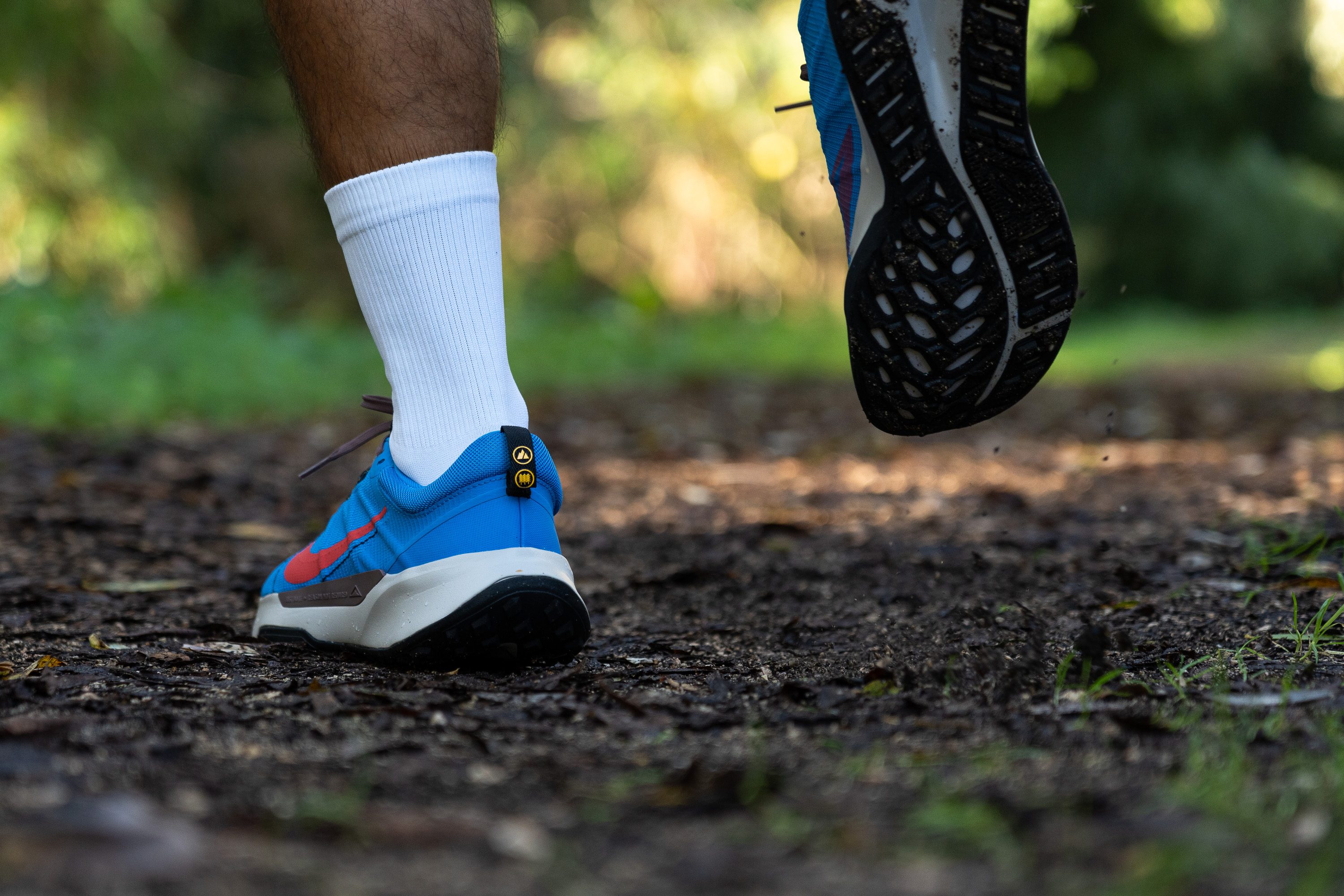

| Juniper Trail 2 | 95.0 mm |
| Average | 89.8 mm |
Durability
Toebox durability
Average breathability can result in decent durability, and that's precisely the case with the Juniper Trail 2 (3/5).
The mesh Nike uses isn't the most comfortable—which is okay for a $85 shoe—but its upside is evident in our Dremel test where it demonstrated impressive resistance, outperforming many other trail running shoes.

| Juniper Trail 2 | 3 |
| Average | 3.1 |
Heel padding durability
The heel performed even better than the outsole, scoring a 4/5 in our Dremel test.
It's pretty clear to us that Nike has prioritized durability above all else, and this focus has definitely paid off.
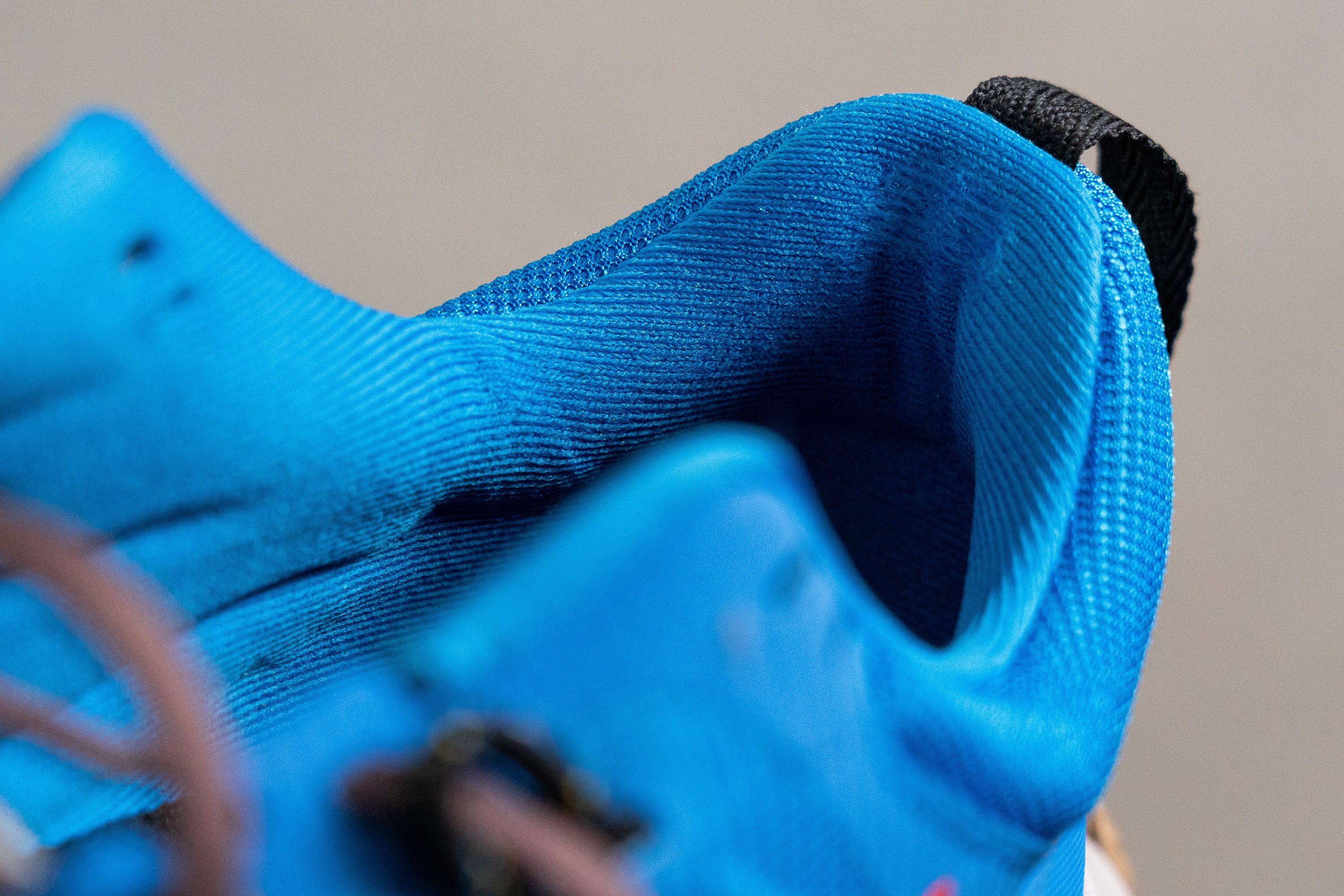
| Juniper Trail 2 | 4 |
| Average | 3 |
Outsole hardness
Turning the shoe over to examine the outsole, we noticed a design that resembles road running shoes, enhanced with some lugs. However, it doesn't quite fit the typical trail running outsole category.

The durometer test resulted in a 91.4 HC reading, likely an attempt to further enhance durability by using a harder rubber blend.
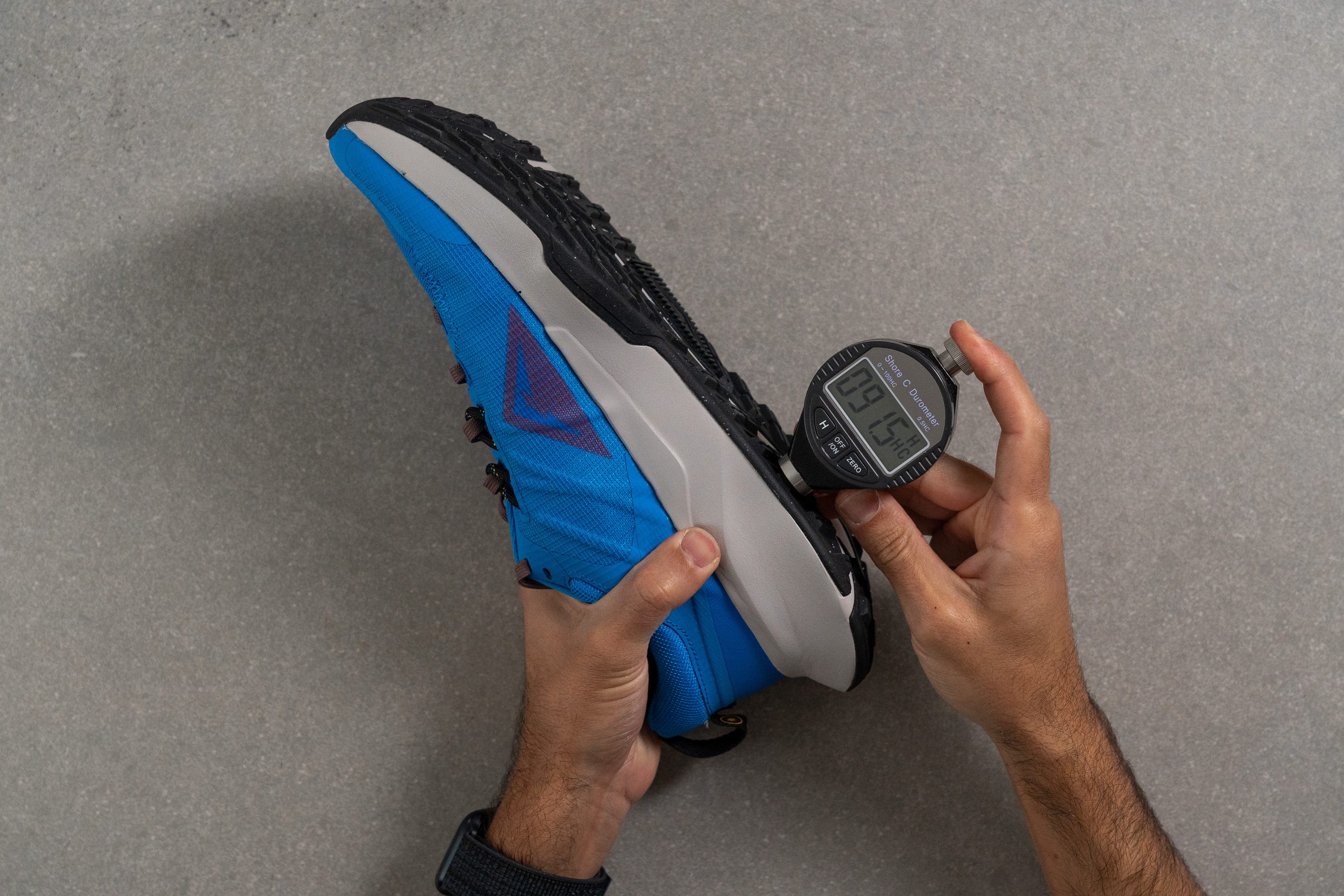
| Juniper Trail 2 | 91.4 HC |
| Average | 85.8 HC |
Outsole durability
Brands often opt for lower quality rubber blends in budget-friendly running shoes to keep costs at bay. While this is understandable, it undeniably affects performance.
To assess this, we used the Dremel for the last time with this shoe and recorded a 1.1-mm indentation, which is substantial for such hard rubber.
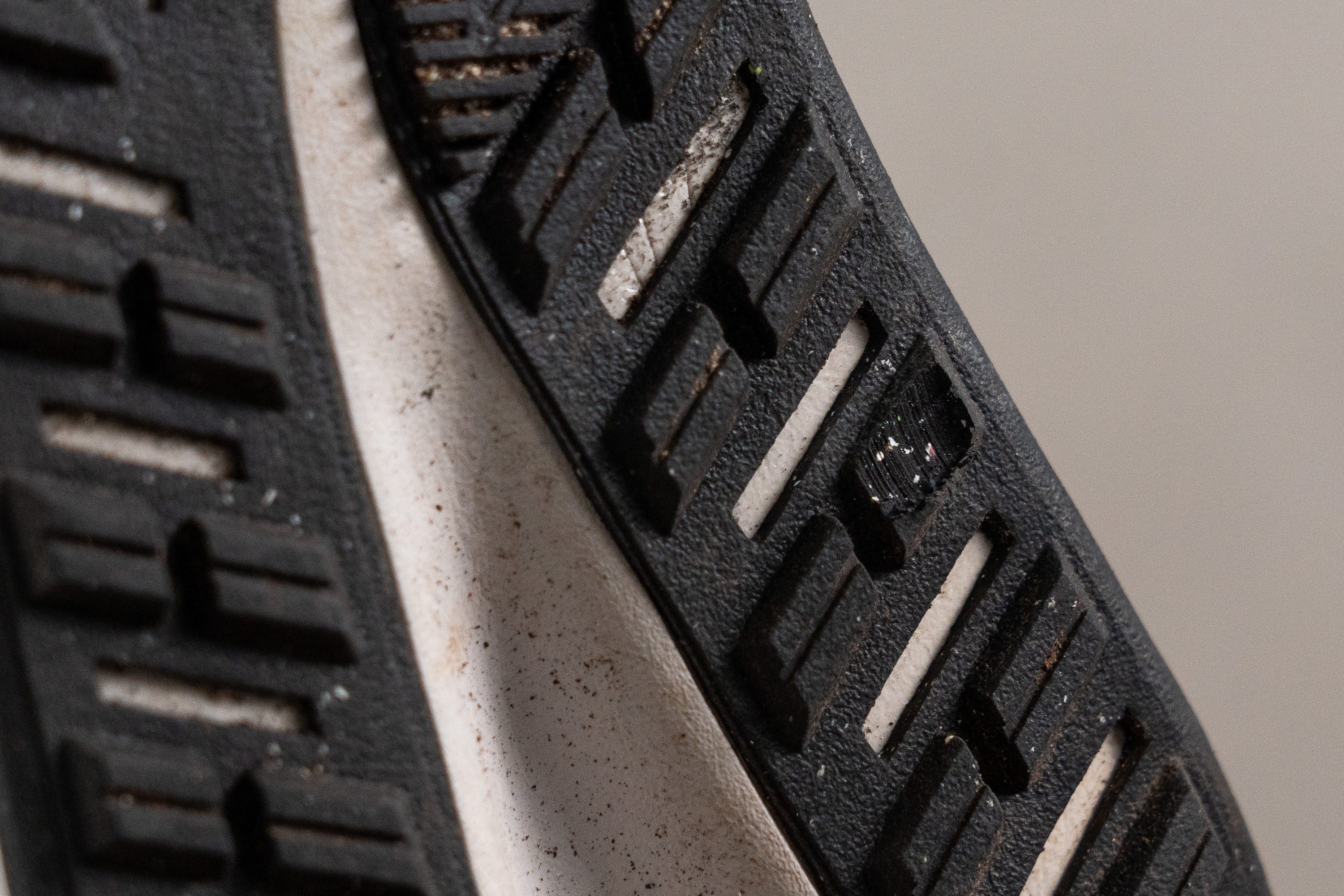
| Juniper Trail 2 | 1.1 mm |
| Average | 0.9 mm |
Outsole thickness
The outsole thickness is about average at 2.3 mm, a reasonable value for ensuring sufficient durability. This is particularly noteworthy since this shoe hasn't proven to have the most durable outsole on the market.

| Juniper Trail 2 | 2.3 mm |
| Average | 2.2 mm |
Misc
Insole thickness
The insole is fairly average, perhaps slightly thinner than usual at 3.9 mm, but it's nothing concerning. We hadn't any discomfort with it, and that's about the best compliment we can give an insole!
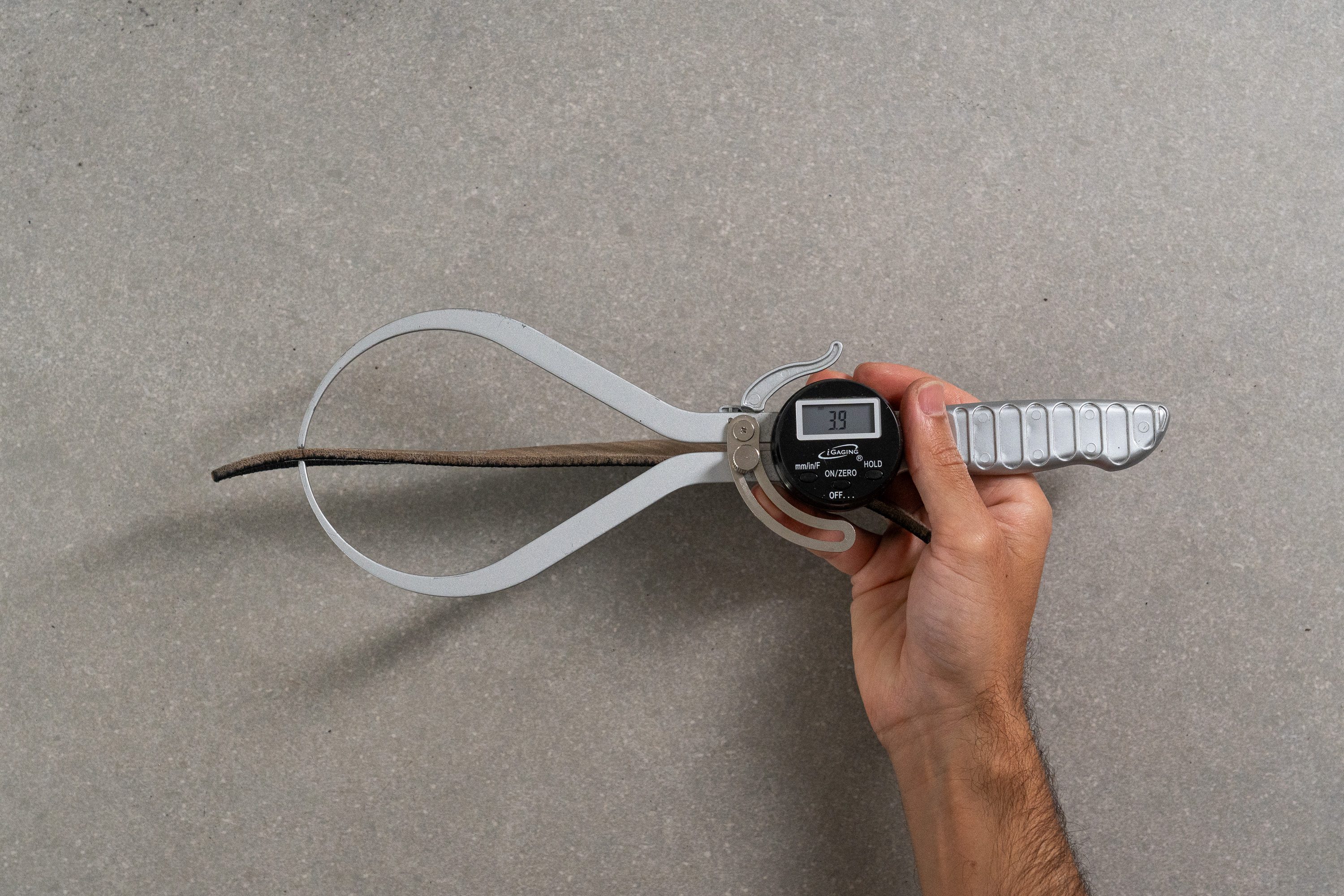
| Juniper Trail 2 | 3.9 mm |
| Average | 4.7 mm |
Removable insole
The insole is removable, and thanks to the roomy design of the Juniper Trail 2, you can expect almost any third-party insole to fit comfortably inside the shoe.

| Juniper Trail 2 | Yes |
Midsole softness in cold
In cold temperatures, the Juniper Trail 2 turns quite stiff, almost brick-like.
How do we know? We placed it alongside our ice creams for 20 minutes and then re-tested it. The result was 34.8 HA on our durometer, indicating a slight decrease in softness.
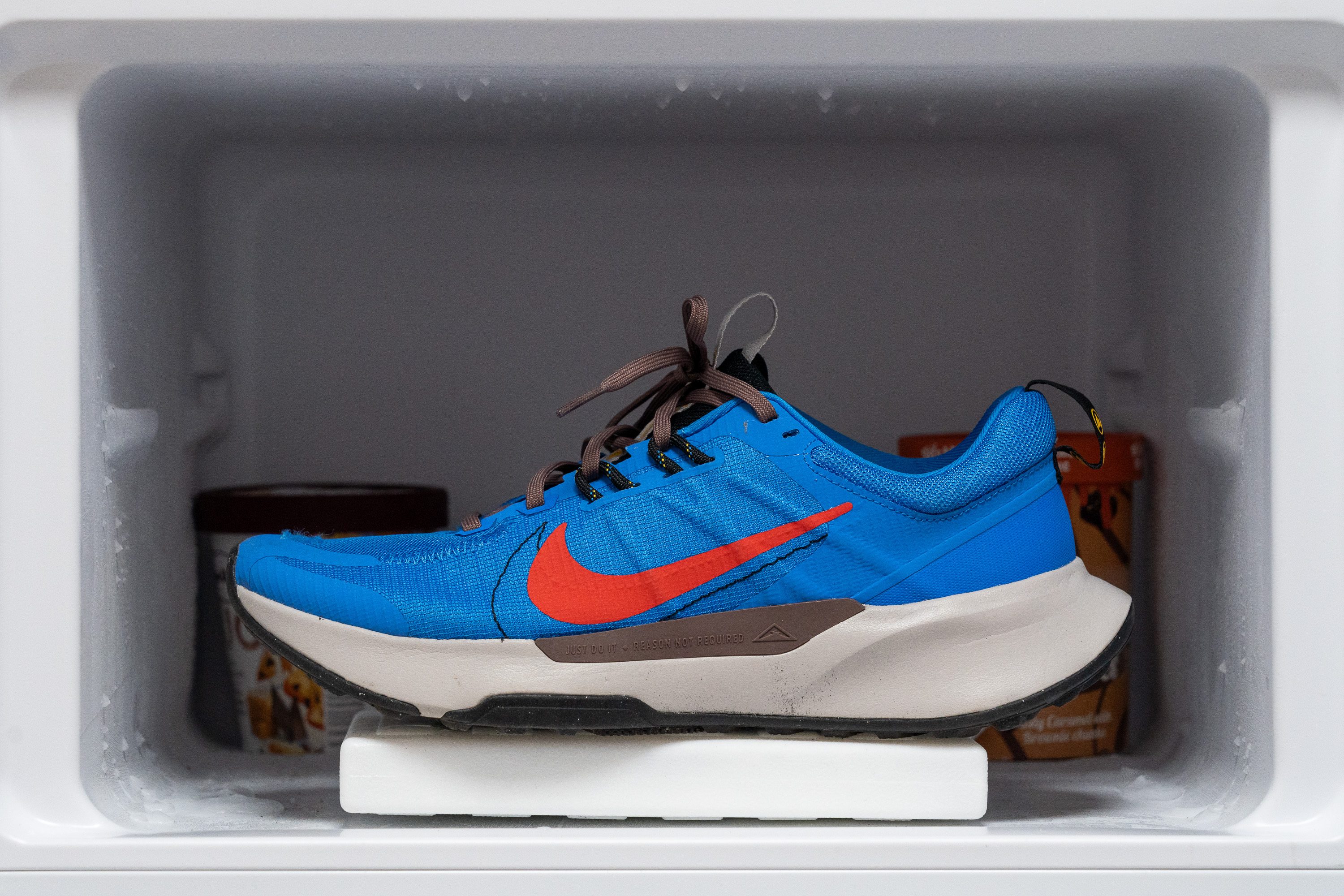
| Juniper Trail 2 | 34.8 HA |
| Average | 27.3 HA |
Midsole softness in cold (%)
That's a 28.1% increase, an incredible result for an EVA-based shoe that's also wallet-friendly. We're actually quite impressed with this performance!
| Juniper Trail 2 | 28% |
| Average | 26% |
Reflective elements
Oh boy, no reflective elements on a trail running shoe... we're not fans of that.
If it's about cutting costs, Nike should maybe ditch the heel tab and throw in some cool reflective pieces on the upper instead!
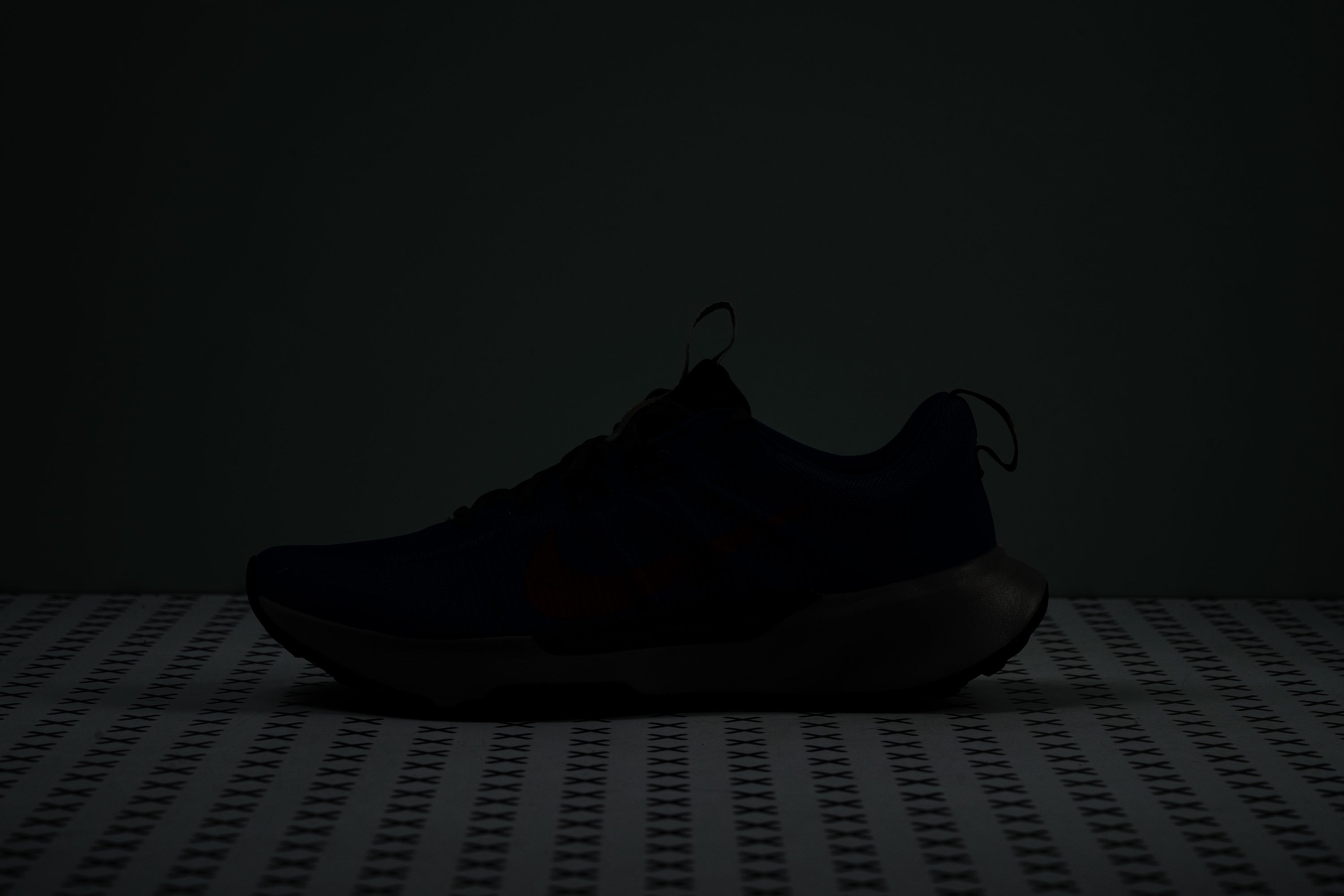
| Juniper Trail 2 | No |
Tongue padding
The tongue really steps up its game too. It's super padded at 9.4 mm, rocking not just one, but two layers of foam. So you'll be able to tighten the laces as much as you like!
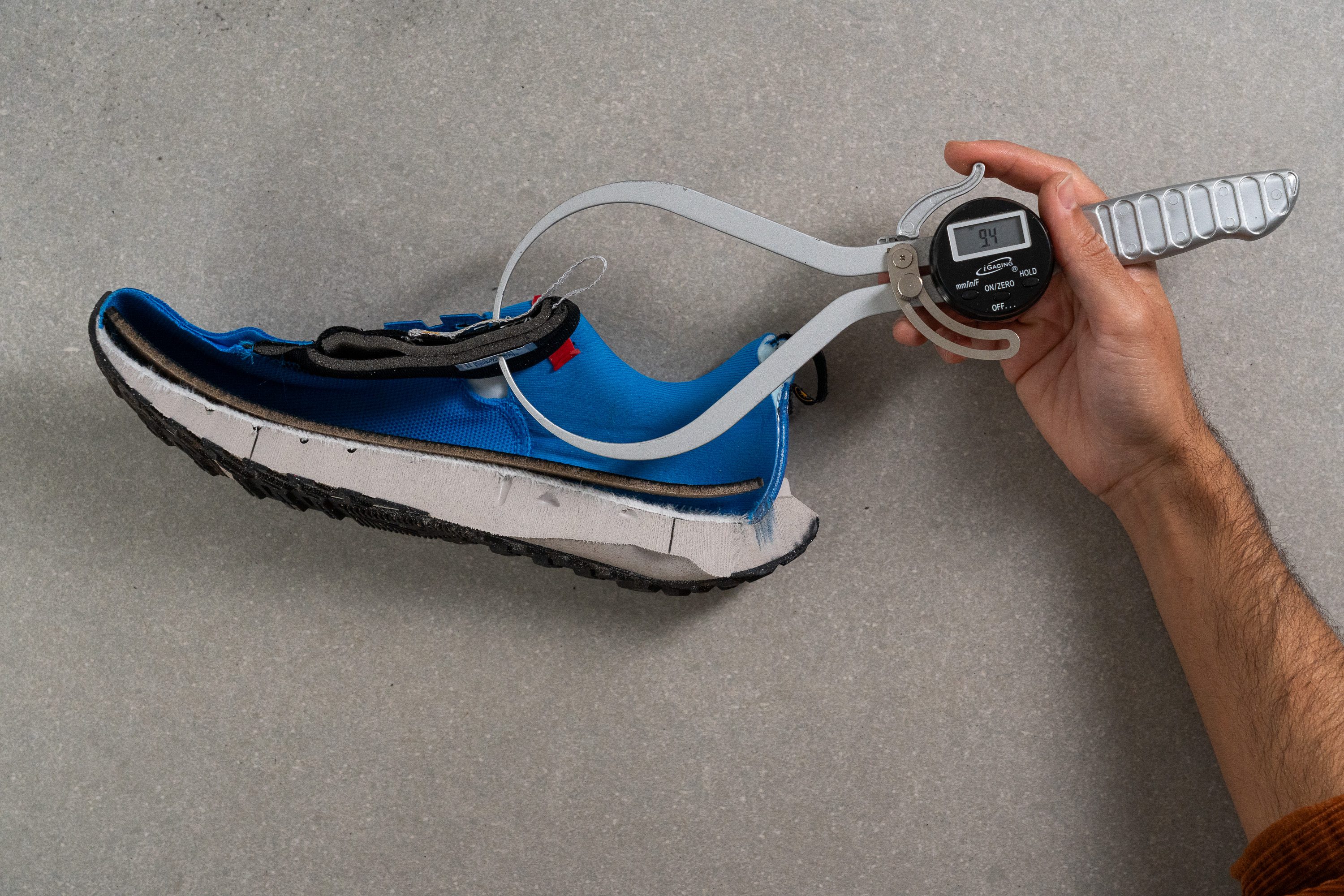
| Juniper Trail 2 | 9.4 mm |
| Average | 6.4 mm |
Tongue: gusset type
A gusseted tongue in a $85 trail shoe? That's truly impressive and definitely deserves applause. This feature enhances the lockdown and makes a noticeable difference in the overall fit and comfort.
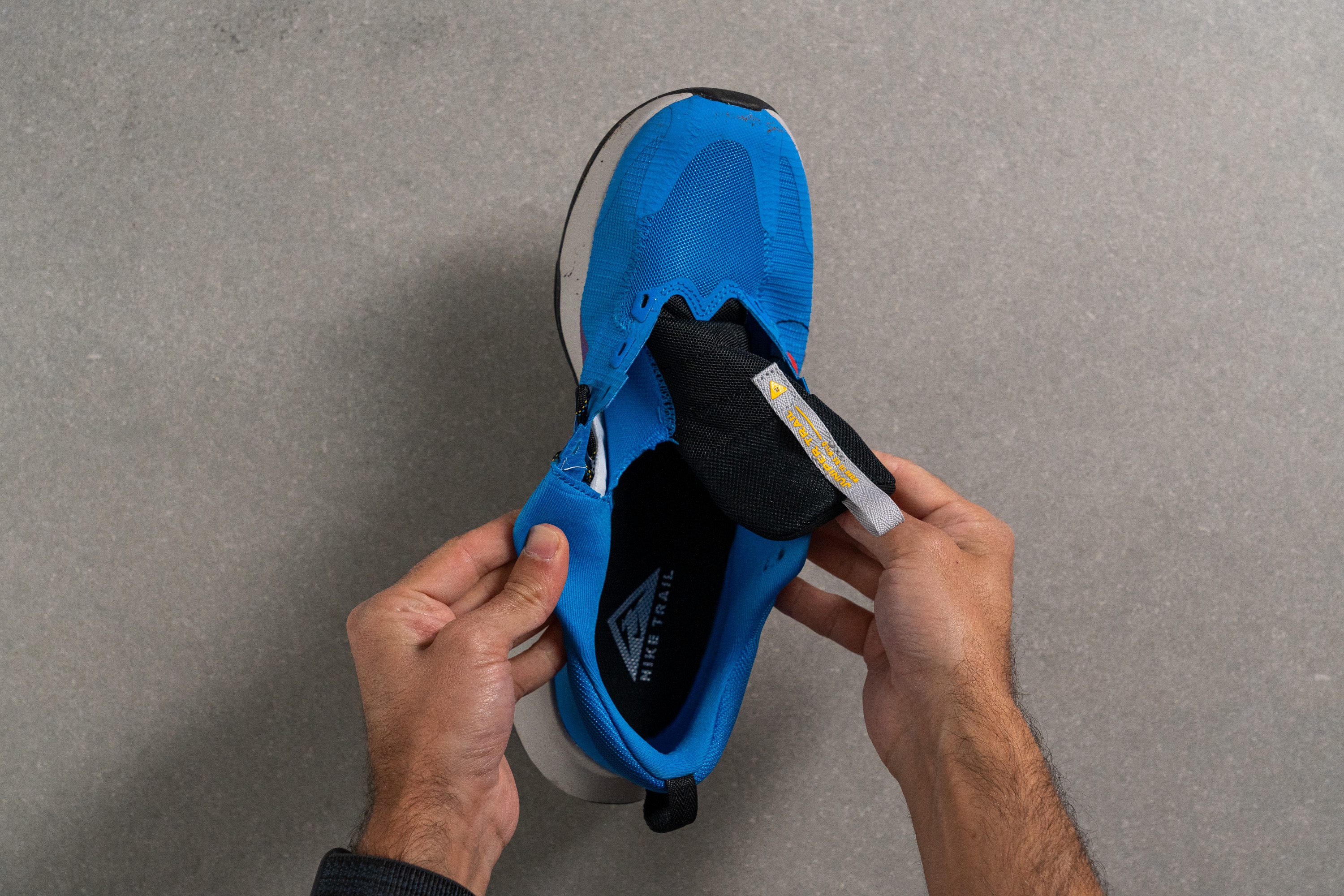
| Juniper Trail 2 | Bootie |
Heel tab
At the back of the shoe, there's a cool finger loop heel tab that really adds to its overall look!
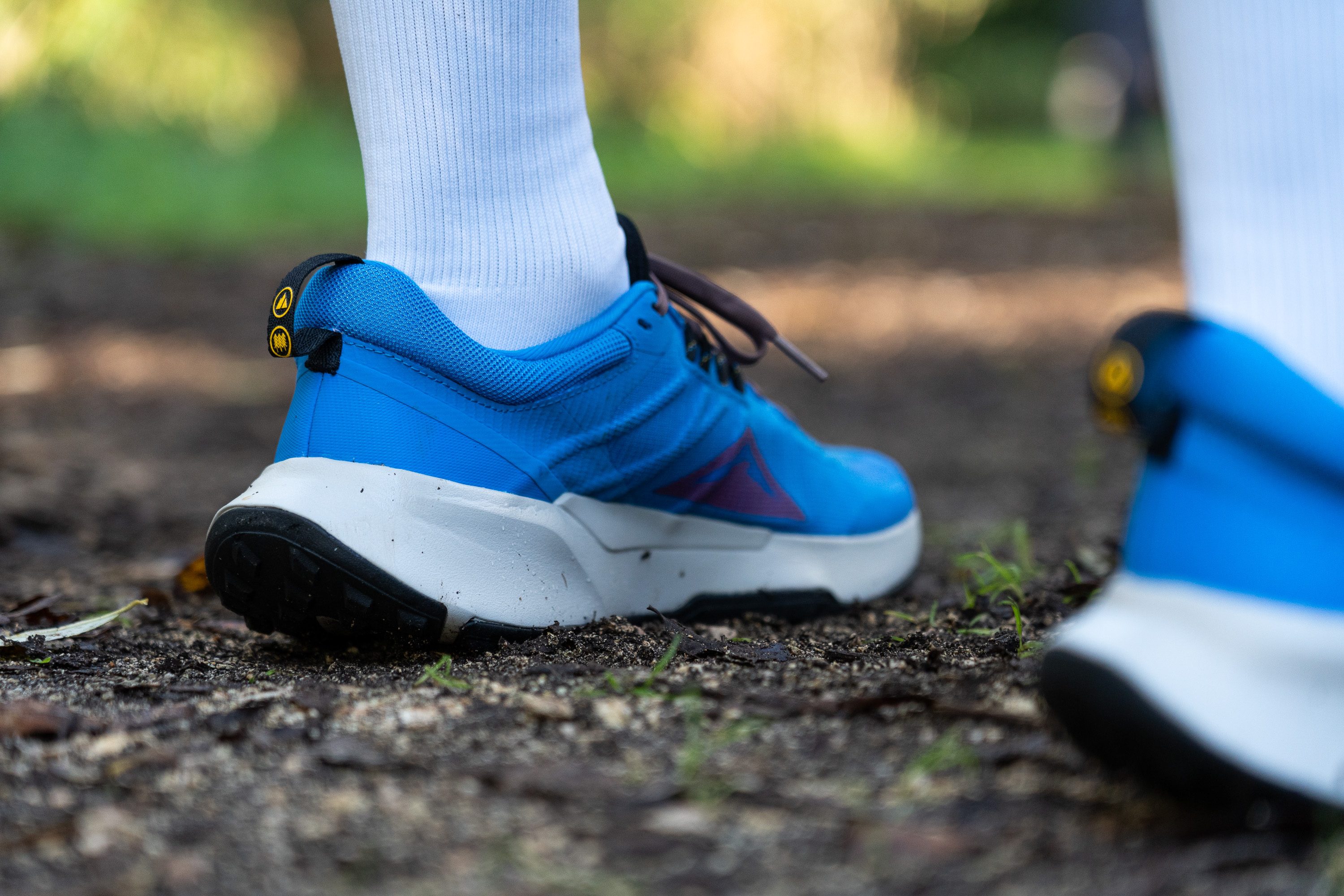
| Juniper Trail 2 | Finger loop |

